Marketers are constantly looking for ways to speak to their customers, but how can they truly stand out in the sea of marketing messages that customers receive? The answer lies in targeting customers with relevant messages at the right time on platforms of their choice.
Customer data is the way forward, but successfully categorising it and putting it to work is a lengthy and complex task. To that end, CM.com has a super smart tool to help marketers and brands improve their customer experience – Customer Data Platform (CDP).
CM.com’s CDP combines data from multiple sources to create a unified, holistic view of each customer. This data can then be used to improve customer experience by giving customers access to relevant products and services.
Customer data normally exists in separate systems or in silos. These data silos don’t communicate with each other, leading to duplicate data points and marketers sending customers confusing information.
As per a PWC report, 59% of customers are willing to walk away from their favourite brand after a number of bad customer service experiences. Additionally McKinsey reported that those marketers and companies that do not figure out a strategy to maintain—and even grow—their access to first-party data may have to spend 10-20% more on marketing and sales to generate the same returns.
The need for CDP
There are four key places where CDP is beneficial:
1. Unifying data from various sources
2. Leveraging data to engage customers with targeted, omnichannel marketing campaigns
3. Discarding unreliable data and focusing mainly on first-party data
4. Personalising communication as per customer behaviour
But despite these advantages, marketers often confuse CDP with Customer Relationship Management (CRM) or Data Management Platforms (DMPs). However, CDP doesn’t act as a replacement for either CRM or DMP, but supports both platforms.
While CRM helps marketers collect first-party data or data gathered directly from their own data collection efforts, enabling businesses to nurture leads, manage customers better, and improve collaboration within sales teams, they are also vulnerable to human error and depend heavily on sales teams.
DMPs help process and organise second-party data or data that’s been sourced from outside of their organisation, and third-party data or anonymised data collected from third-party browser cookies. They rely on cookie-based information and use anonymous IDs for profiles.
Businesses need CDP to bridge the gap between first, second and third-party data. CDPs combine and collect customer data from multiple sources: creating a unified, complete view of each customer.
A glimpse into CDP
A CDP is a prebuilt system, configured to meet the needs of each client. Some technical resources will be required to set up and maintain the CDP, but it does not require the level of technical skill of a typical data warehouse project. The platform pools and tracks customer data, such as behavioural data and demographics, and uses this data to create a 360-degree view of each customer.
The main aim of CDP is to provide a single source of truth for customer data that can be used to personalise and optimise the customer experience.
Apart from data unification, CDPs help in data integration, data management and cleaning, segmentation, profile management of customers, and real-time decisions to help marketers offer personalised experiences.
The CM.com advantage
CM.com’s CDP solution is beneficial for a lot of reasons, ranging from personalization and improved customer experience to segmentation and optimisation.
Through CM.com, brands can:
1. Build 360° customer profiles: The solution prevents data from slipping through the cracks by unifying customer data into 360˚ customer profiles.
2. Create segments based on customer behaviour: Brands can create their own segments to target customers better through criteria such as channel engagement, user location, birthdays, purchase history, web behaviour or more.
3. Achieve 1:1 personalisation: By collecting data events of customers’ interactions and behaviour patterns, the platform helps brands personalise their messaging.
4. Automate with workflows: Brands can automate interactions with customers with personal workflows, and create omnichannel customer journeys.
CM.com’s CDP solution helps brands ensure their customers get a seamless onboarding journey. It lets them know customers better, re-engage with them, increase customer retention and loyalty, and even create personalised offers for special moments in a customer’s life.
Why do you need CDP?
We are living in a competitive world, where brands are trying their hardest to outperform one another. This makes a deep understanding of customers key. Because only when you know your customers can you offer personalised experiences so that they return and re-engage.
CDP is expected to play a crucial role in the future of customer engagement by offering:
1. Greater intelligence: New-age technology such as advanced analytics, machine learning, and artificial intelligence will seep into the solution and help marketers gain deeper insights into customer behaviour and preferences.
2. Increased automation: Right from data collection and data integration to data cleaning and data enrichment, each step will be automated.
3. Real-time customer data: In the future, CDPs will help businesses organise customer data in real time, allowing them to deliver highly personalised experiences.
4. More integrated services: CDP could become a solution that can be integrated into CRM or analytic platforms to provide end-to-end support in customer journeys.
5. Evolved privacy: CDPs will focus on data privacy in the years ahead to protect customer trust.
As CDP becomes more and more important, it is important for brands to not miss out on the opportunity it offers.
To take your customer experience to the next level and contact CM.com,










